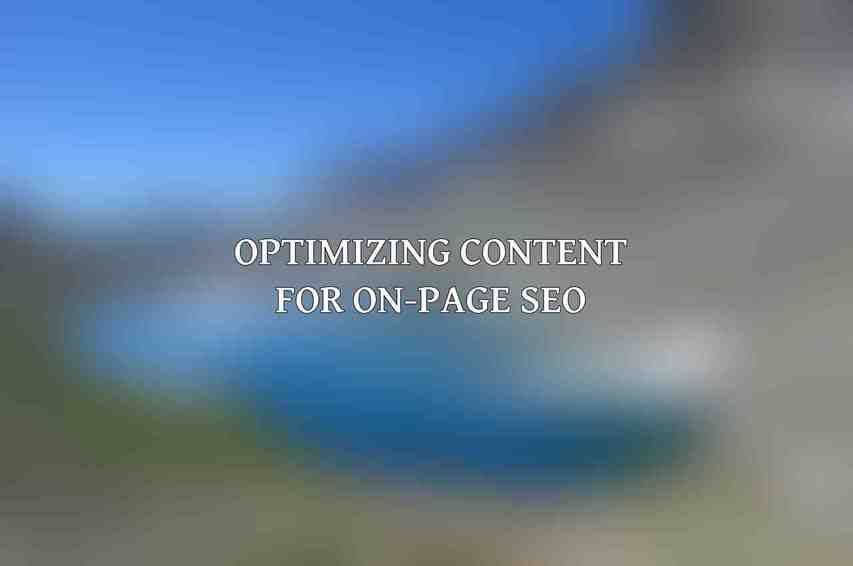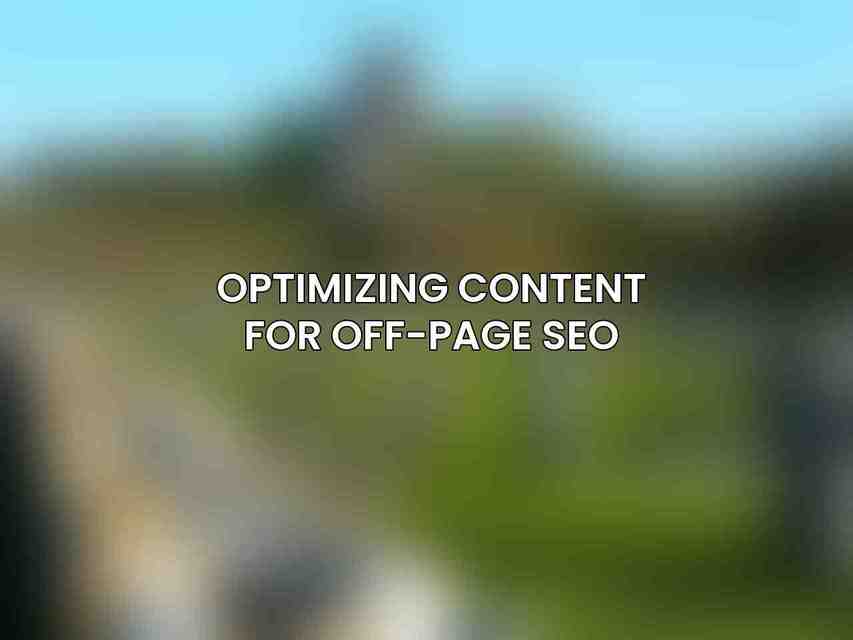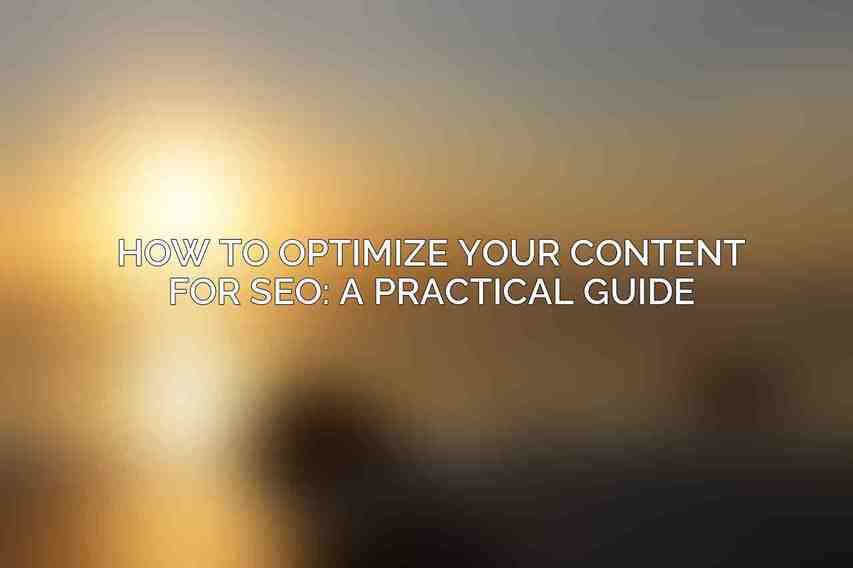Search Engine Optimization (SEO) is the practice of enhancing the quantity and quality of traffic to your website through organic search engine results. It involves understanding how search engines work, what people search for, and the keywords they use. Search engines like Google use complex algorithms to determine which websites rank highest for specific queries. These algorithms consider various ranking factors such as relevance, usability, and authority.
Optimizing your content for SEO offers numerous benefits for your online presence. By implementing proper SEO strategies, you can increase organic traffic to your website, improve brand visibility and recognition, and ultimately lead to higher conversion rates. A well-optimized website is more likely to attract the right audience and drive meaningful engagement.
Keyword research plays a crucial role in content optimization for SEO. It is essential to choose relevant keywords that align with your content and target audience. Tools like Google Keyword Planner, SEMrush, and Ahrefs help in identifying high-volume keywords and assessing their competitiveness. Understanding the difference between long-tail keywords (specific phrases with lower search volume but higher conversion rates) and short-tail keywords (broader terms with higher search volume) is key to developing an effective keyword strategy.
Optimizing Content for On-Page SEO

A. Title Tags
Title tags are HTML elements that define the title of a web page. They are displayed on search engine results pages as the clickable headline for a given result. Optimizing title tags involves incorporating relevant keywords, maintaining an ideal length (typically 50-60 characters), and following a clear structure that accurately describes the content of the page.
B. Meta Descriptions
Meta descriptions provide a brief summary of the content on a web page. While they do not directly impact search engine rankings, well-crafted meta descriptions can influence click-through rates. Effective meta descriptions are concise, compelling, and contain relevant keywords to attract users’ attention on the search results page.
C. Headers and Subheaders (H Tags)
Headers (H1, H2, H3, etc.) are used to structure content hierarchically, making it easier for both users and search engines to understand the context of the page. Including relevant keywords in headers helps search engines determine the main topics of the content, improving its visibility and relevance.
D. Body Content
Creating high-quality, valuable content is essential for on-page SEO. Content length and density should be optimized for readability and engagement, while strategically placing keywords throughout the text can improve visibility in search results. Internal linking to relevant pages within your website helps search engines navigate and index your content effectively. Read more about this on Top Content Marketing Tools Reviewed: Empower Your Strategy
E. Image Optimization
Optimizing images on your website is essential for SEO. This includes using descriptive file names that include keywords, providing alt tags to describe images for accessibility and SEO purposes, and compressing images to improve page load speed, which can positively impact search rankings.
Optimizing Content for Off-Page SEO

A. Link Building
Link building is a critical aspect of off-page SEO that involves acquiring backlinks from other websites. Backlinks are like “votes of confidence” from other sites, indicating trust and authority to search engines. Building high-quality backlinks from reputable sources can significantly impact your website’s search rankings.
B. Social Media Engagement
Social media plays a significant role in influencing SEO rankings. By actively engaging with your audience on platforms like Facebook, Twitter, and LinkedIn, you can increase brand visibility, drive traffic to your website, and encourage social sharing of your content. Optimizing your content for social sharing by including social sharing buttons and creating shareable, engaging posts can enhance your online presence.
C. Local SEO
For businesses targeting a local audience, optimizing for local SEO is crucial. This involves creating and managing local listings on platforms like Google My Business, ensuring consistency in NAP (Name, Address, Phone Number) information across online directories, and implementing local search optimization techniques like geo-targeted content and local keyword targeting.
Measuring and Tracking SEO Results
A. Using Analytics Tools
Analytics tools like Google Analytics and Google Search Console provide valuable insights into website performance, user behavior, and search engine visibility. By monitoring metrics like organic traffic, keyword rankings, and bounce rate, you can assess the effectiveness of your SEO efforts and make data-driven decisions for optimization.
B. Key Performance Indicators (KPIs) to Track
Key performance indicators related to SEO performance include organic traffic growth, keyword rankings improvement, and decrease in bounce rates. Tracking these KPIs over time allows you to measure the impact of your SEO strategies and make adjustments for better results.
C. Reporting and Analysis
Regularly analyzing SEO reports and performance metrics is essential for understanding what is working well and where there is room for improvement. Reporting on key metrics to stakeholders and clients helps demonstrate the value of SEO efforts and informs future optimization strategies.
Best Practices for Ongoing Content Optimization
A. Regularly Updating and Refreshing Content
Keeping your content fresh and relevant is crucial for maintaining search visibility and user engagement. Regularly updating blog posts, product pages, and other content assets signals to search engines that your website is active and valuable to users.
B. Monitoring Search Engine Algorithm Updates
Search engines constantly update their algorithms to improve search results. Staying informed about algorithm changes and understanding how they may impact your website’s rankings helps you adapt your SEO strategies accordingly and stay ahead of the competition.
C. Keeping Up with Industry Trends
The field of SEO is constantly evolving, with new trends, technologies, and best practices emerging regularly. Keeping up with industry trends through reputable SEO publications, forums, and conferences ensures that you are aware of the latest developments and can incorporate them into your optimization strategies.
D. Using SEO Tools and Resources
Utilizing a variety of SEO tools and resources can streamline your optimization efforts and provide valuable insights into your website’s performance. Tools like Moz, SEMrush, and Ahrefs offer features for keyword research, site audits, backlink analysis, and more to help you optimize your content effectively.
E. Collaborating with SEO Professionals
For complex SEO projects or ongoing optimization needs, working with experienced SEO professionals can provide expertise and guidance to achieve your optimization goals. SEO agencies and consultants can offer strategic advice, technical support, and implementation assistance to enhance your SEO strategy.
optimizing your content for SEO is a comprehensive process that involves understanding search engine algorithms, implementing on-page and off-page optimization techniques, tracking performance metrics, and staying informed about industry trends. By following best practices and utilizing available tools and resources, you can enhance your website’s visibility, attract more organic traffic, and improve user engagement for long-term success in the digital world.
Frequently Asked Questions
What is SEO?
SEO stands for Search Engine Optimization, which is the practice of increasing the quantity and quality of traffic to your website through organic search engine results.
How important is content optimization for SEO?
Content optimization is crucial for SEO as search engines rely on relevant and high-quality content to rank websites. By optimizing your content, you can improve your chances of being found by potential customers.
What are some key elements to consider when optimizing content for SEO?
Key elements to consider when optimizing content for SEO include using relevant keywords, creating high-quality and engaging content, optimizing meta tags, adding internal and external links, and ensuring mobile-friendliness.
How can I research relevant keywords for my content optimization?
You can research relevant keywords using keyword research tools like Google Keyword Planner, SEMrush, or Ubersuggest. Focus on long-tail keywords that are specific to your niche and have low competition but high search volume.
How long does it take to see results from content optimization for SEO?
The time it takes to see results from content optimization for SEO can vary depending on factors like the competitiveness of your industry, the quality of your content, and your website’s domain authority. In general, you may start seeing improvements in your search rankings within a few weeks to a few months of implementing content optimization strategies.

